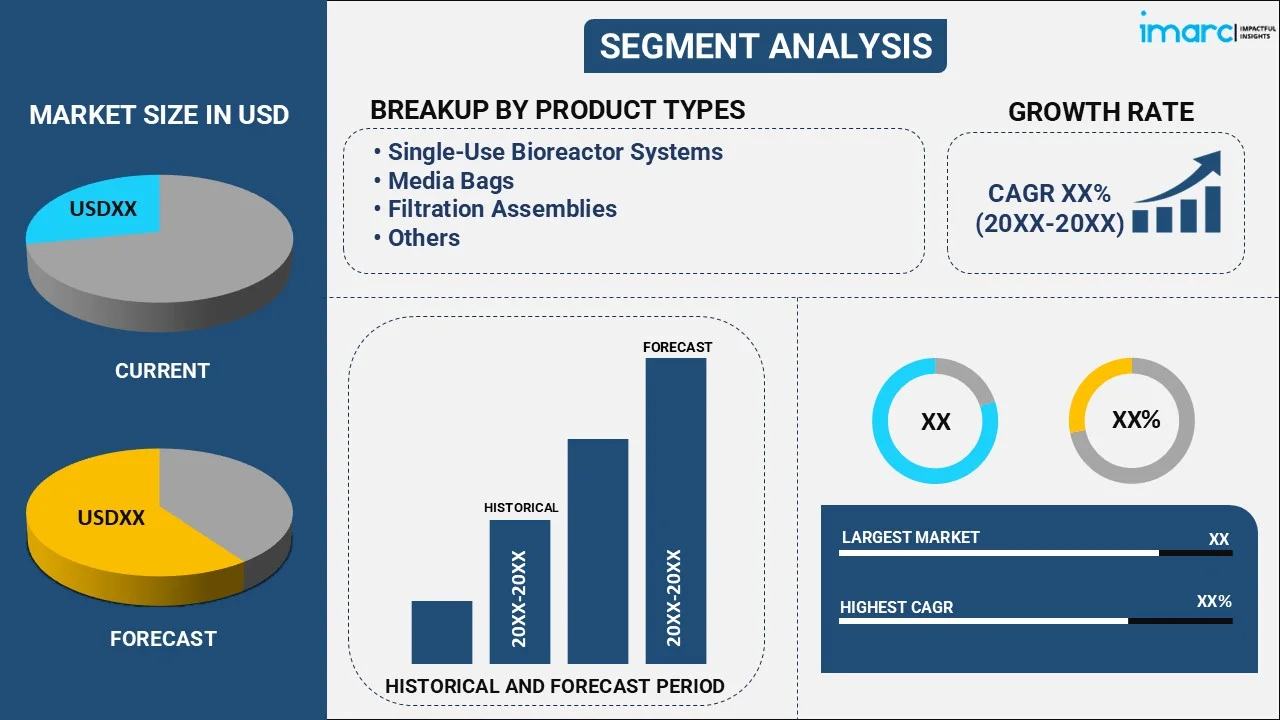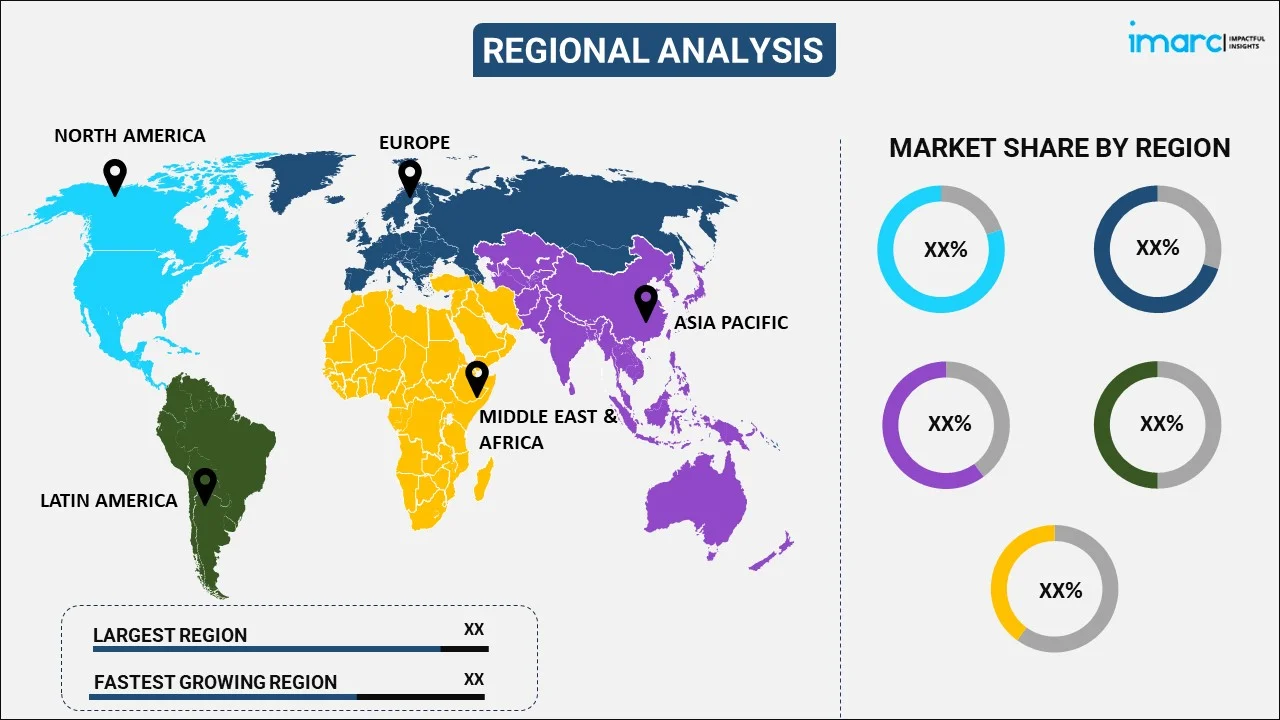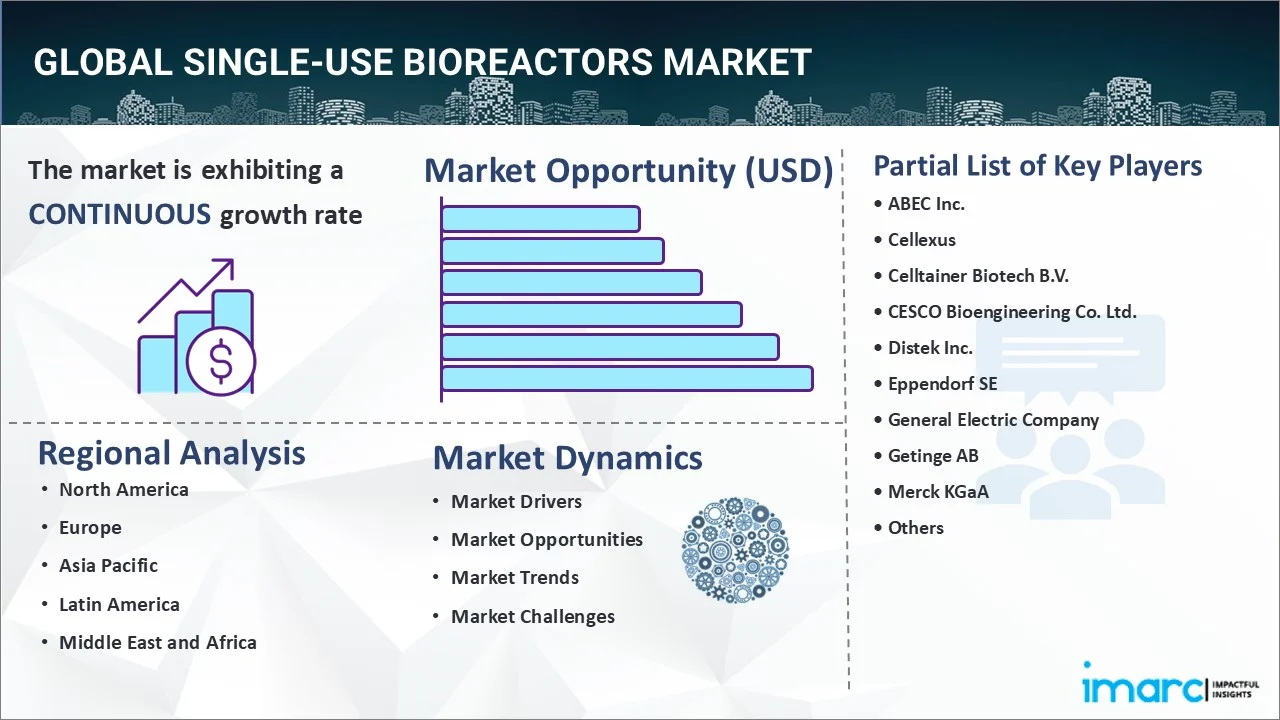
Single-Use Bioreactors Market Report by Product Type (Single-use Bioreactor Systems, Media Bags, Filtration Assemblies, and Others), Type (Stirred-tank Bioreactors, Wave-induced Bioreactors, Bubble-column Bioreactors, and Others), Cell Type (Mammalian Cell, Bacteria, Yeast, and Others), Molecule Type (Vaccines, Monoclonal Antibodies, Stem Cells, Recombinant Proteins, and Others), End User (Pharmaceutical and Biopharmaceutical Companies, Contract Research Organizations, Academic and Research Institutes, and Others), and Region 2025-2033
Single-Use Bioreactors Market Size:
The global single-use bioreactors market size reached USD 3.9 Billion in 2024. Looking forward, IMARC Group expects the market to reach USD 12.4 Billion by 2033, exhibiting a growth rate (CAGR) of 13.1% during 2025-2033. The market is propelled by the increasing demand for biopharmaceuticals, cost-efficiency and scalability offered by the product, significant developments in single-use technology, increasing product adoption in contract manufacturing organizations (CMOs), rising usage in cell and gene therapy production.
|
Report Attribute
|
Key Statistics
|
|---|---|
|
Base Year
|
2024
|
|
Forecast Years
|
2025-2033
|
|
Historical Years
|
2019-2024
|
|
Market Size in 2024
|
USD 3.9 Billion |
|
Market Forecast in 2033
|
USD 12.4 Billion |
| Market Growth Rate 2025-2033 | 13.1% |
Single-Use Bioreactors Market Analysis:
- Major Market Drivers: Increasing demand for biopharmaceuticals, cost-efficiency and scalability offered by the product, and significant developments in single-use technology are some of the major market drivers.
- Key Market Trends: Growing product adoption in contract manufacturing organizations (CMOs), increasing utilization in cell and gene therapy productions, and significant advancements in bioreactor design are some single-use bioreactors key market trends.
- Geographical Trends: North America dominates the market on account of the increasing usage of biopharmaceuticals, rising investment in bioprocessing technologies, and growing benefits of single-use systems more than conventional-steel bioreactors.
- Competitive Landscape: ABEC Inc., Cellexus, Celltainer Biotech B.V., CESCO Bioengineering Co. Ltd., Distek Inc., Eppendorf SE, General Electric Company, Getinge AB, Merck KGaA, Pall Corporation (Danaher Corporation), PBS Biotech Inc., Sartorius AG and Thermo Fisher Scientific Inc., are among some of the key players in the single-use bioreactors industry.
- Challenges and Opportunities: Some of the challenges of the industry include high initial product costs and increasing concerns about plastic waste. Whereas, opportunities of the market include the significant technological developments in single-bioreactor designs and the rising demand for personalized medicine and small-batch production.
Single-Use Bioreactors Market Trends:
Rising Adoption of Biopharmaceuticals
The biopharmaceutical industry is rapidly growing on account of the increasing demand for new and effective treatments for numerous diseases, including chronic diseases, such as diabetes, cancer, and autoimmune disorders. According to the IMARC GROUP, the global biopharmaceuticals market has reached US$ 300.5 Billion in 2023, and is expected to reach US$ 643.9 Billion by 2032, exhibiting a CAGR of 8.6% during 2024-2032. Biopharmaceuticals which possess vaccines, monoclonal antibodies, and recombinant proteins, are produced using living cells, which need highly specialized production environments. Single-use bioreactors (SUBs) are highly adopted on account of their cost-efficiency, flexibility, and reduced risk of cross-contamination. They allow quicker product development and production times, thus enabling biopharmaceutical companies to rapidly cater to these demands and develop new therapies for patients.
Rising Investment in Bioprocessing Technologies
The rising investment in bioprocessing technologies is increasing as they seek to improve their production capabilities and enhance operational efficiencies. As per a report published by the IMARC GROUP, the global bioprocess technology market has reached US$ 29.2 Billion in 2023, and is expected to reach US$ 53.3 Billion by 2032, exhibiting a CAGR of 6.93% during 2024-2032. Single-use bioreactors are able to organize the bioprocessing workflow by offering a wide variety of benefits such as reduced capital expenditure, minimized cleaning and validation requirements, and better flexibility in scaling up or down production volumes. Key players are extensively investing in single-use technologies to maximize their production processes, minimize downtime, and achieve cost-efficiency.
Favorable Regulatory Support and Favorable Government Policies
Regulatory agencies and government bodies play a major role in evolving the landscape of biopharmaceutical manufacturing by enduring guidelines and frameworks that guarantee product safety, efficacy, and quality. In recent years, there has been a growing recognition of the benefits of single-use bioreactors (SUBs) within the regulatory community. Regulatory agencies such as the U.S. Food and Drug Administration (FDA) and the European Medicines Agency (EMA) have been supportive of single-use technologies due to their ability to reduce contamination risks and improve process efficiencies. This regulatory support has provided a conducive environment for the adoption of SUBs, encouraging biopharmaceutical companies to invest in these systems.
Single-Use Bioreactors Industry Segmentation:
IMARC Group provides an analysis of the key trends in each segment of the market, along with forecasts at the global, regional, and country levels for 2025-2033. Our report has categorized the market based on product type, type, cell type, molecule type, and end user.
Breakup by Product Type:

- Single-use Bioreactor Systems
- Media Bags
- Filtration Assemblies
- Others
Single-use bioreactor systems accounts for the majority of the market share
The single-use bioreactors market report has provided a detailed breakup and analysis of the market based on the product type. This includes single-use bioreactor systems, media bags, filtration assemblies, and others. According to the report, single-use bioreactor systems represented the largest segment.
Single-use bioreactor systems dominate the market on account of the numerous benefits offered by them. These are meant for single time usage, which eliminates the need of the vigorous cleaning and sterilization procedure that stainless-steel bioreactors need. This in turn minimizes the downtime between production runs, improves operational efficiency, and reduces the risk of cross-contamination, which is vital in biopharmaceutical production.
Breakup by Type:
- Stirred-tank Bioreactors
- Wave-induced Bioreactors
- Bubble-column Bioreactors
- Others
Stirred tank bioreactors holds the largest share in the industry
A detailed breakup and analysis of the market based on the type have also been provided in the report. This includes stirred-tank bioreactors, wave-induced bioreactors, bubble-column bioreactors, and others. According to the report, stirred tank bioreactors accounted for the largest market share.
Stirred tank bioreactors hold maximum number of single-use bioreactors market share on account of their efficiency, scalability, and versatility in a wide variety of bioprocessing applications. These bioreactors are built to offer optimized mixing and aeration conditions, which are vital for maintaining uniform cell culture environments and achieving high cell densities and product results. This type of single-use bioreactors is appropriate for both microbial and mammalian cell cultures, thereby making it a preferred choice for creating a wide variety of biopharmaceutical products, such as vaccines, monoclonal antibodies, and recombinant proteins.
Breakup by Cell Type:
- Mammalian Cell
- Bacteria
- Yeast
- Others
Mammalian cell represents the leading market segment
The report has provided a detailed breakup and analysis of the market based on the cell type. This includes mammalian cell, bacteria, yeast, and others. According to the report, mammalian cell represented the largest segment.
Mammalian cells hold the largest market share due to several critical factors. Initially, mammalian cells are critical for producing complex biopharmaceuticals such as monoclonal antibodies, recombinant proteins, and vaccines. These therapeutic agents need mammalian cells for their post-translational modifications, which are crucial for their functional and structural integrity. Unlike microbial or yeast cells, mammalian cells can perform glycosylation and other modifications that are vital for the efficacy and safety of biopharmaceutical products. Mammalian cells possess the ability to produce human-like glycosylation patterns which further makes them irreplaceable for the development of biologics that need to mimic natural human proteins closely.
Breakup by Molecule Type:
- Vaccines
- Monoclonal Antibodies
- Stem Cells
- Recombinant Proteins
- Others
Vaccines exhibits a clear dominance in the market
A detailed breakup and analysis of the market based on the molecule type have also been provided in the report. This includes vaccines, monoclonal antibodies, stem cells, recombinant proteins, and others. According to the report, vaccines accounted for the largest market share.
Vaccines represent the largest segment due to several compelling factors, such as the rising global demand for vaccines, driven by the continuous upsurge of infectious diseases and the need for rapid and effective immunization strategies. The COVID-19 pandemic is a notable instance that has underlined the importance of vaccines, promoting unprecedented investments in vaccine research, development, and production. Single-use bioreactors have become indispensable in this context because of their flexibility, scalability, and ability to support quick production cycles, which are critical for meeting urgent vaccine demands.
Breakup by End User:
- Pharmaceutical and Biopharmaceutical Companies
- Contract Research Organizations
- Academic and Research Institutes
- Others
The report has provided a detailed breakup and analysis of the market based on the end user. This includes pharmaceutical and biopharmaceutical companies, contract research organizations, academic and research institutes, and others.
Pharmaceutical and biopharmaceutical companies are the primary end users of single-use bioreactors. These organizations leverage single-use systems for the production of a wide range of therapeutics, including monoclonal antibodies, recombinant proteins, and, notably, vaccines.
Contract Research Organizations (CROs) are significant users of single-use bioreactors, offering outsourced research services to pharmaceutical and biopharmaceutical companies. CROs utilize these systems to conduct various stages of drug development, including preclinical and clinical research.
Academic and research institutes play a crucial role in the innovation and development of new bioprocessing technologies. These institutions use single-use bioreactors for experimental and educational purposes, focusing on the research and development of new drugs, vaccines, and therapeutic proteins.
Breakup by Region:

- North America
- United States
- Canada
- Asia-Pacific
- China
- Japan
- India
- South Korea
- Australia
- Indonesia
- Others
- Europe
- Germany
- France
- United Kingdom
- Italy
- Spain
- Russia
- Others
- Latin America
- Brazil
- Mexico
- Others
- Middle East and Africa
North America leads the market, accounting for the largest single-use bioreactors market share
The market research report has also provided a comprehensive analysis of all the major regional markets, which include North America (the United States and Canada); Asia Pacific (China, Japan, India, South Korea, Australia, Indonesia, and others); Europe (Germany, France, the United Kingdom, Italy, Spain, Russia, and others); Latin America (Brazil, Mexico, and others); and the Middle East and Africa. According to the report, North America accounted for the largest market share.
North America is the largest segment in the single-use bioreactors market by region due to several key factors. The region is home to a robust biopharmaceutical industry with significant investment in research and development. The presence of major pharmaceutical and biotechnology companies, coupled with a strong focus on innovation and advanced manufacturing technologies, drives the demand for single-use bioreactors. Additionally, North America benefits from well-established regulatory frameworks and government support for biopharmaceutical production, particularly in response to public health challenges such as the COVID-19 pandemic.
Competitive Landscape:
- The market research report has also provided a comprehensive analysis of the competitive landscape in the market. Detailed profiles of all major companies have also been provided. Some of the major market players in the single use bioreactors industry include ABEC Inc., Cellexus, Celltainer Biotech B.V., CESCO Bioengineering Co. Ltd., Distek Inc., Eppendorf SE, General Electric Company, Getinge AB, Merck KGaA, Pall Corporation (Danaher Corporation), PBS Biotech Inc., Sartorius AG and Thermo Fisher Scientific Inc.
(Please note that this is only a partial list of the key players, and the complete list is provided in the report.)
- Key players in the single-use bioreactors industry have undertaken several strategic efforts to drive market growth and innovation. Companies such as Thermo Fisher Scientific, Sartorius Stedim Biotech, and GE Healthcare are at the forefront of these initiatives. One major area of focus has been the continuous enhancement of product portfolios through research and development. These companies invest heavily in developing new and improved bioreactor designs that offer greater efficiency, scalability, and ease of use. Innovations such as automated control systems, improved sensors, and better materials for bioreactor components are some of the advancements being pursued.
Latest News:
- March 2023: MARQMETRIX launched its latest “SINGLE-USE BIOREACTOR BALL PROVE”. This technology reduces the danger of contamination while increasing productivity and lowering expanses.
- March 2023: DISTEK launched the latest edition to the BIOne product line, the BIOne 10L Single-Use Bioreactor (SUB).
Single-Use Bioreactors Market Report Scope:
| Report Features | Details |
|---|---|
| Base Year of the Analysis | 2024 |
| Historical Period | 2019-2024 |
| Forecast Period | 2025-2033 |
| Units | Billion USD |
| Scope of the Report | Exploration of Historical Trends and Market Outlook, Industry Catalysts and Challenges, Segment-Wise Historical and Future Market Assessment:
|
| Product Types Covered | Single-Use Bioreactor Systems, Media Bags, Filtration Assemblies, Others |
| Types Covered | Stirred-tank Bioreactors, Wave-induced Bioreactors, Bubble-column Bioreactors, Others |
| Cell Types Covered | Mammalian Cell, Bacteria, Yeast, Others |
| Molecule Types Covered | Vaccines, Monoclonal Antibodies, Stem Cells, Recombinant Proteins, Others |
| End Users Covered | Pharmaceutical and Biopharmaceutical Companies, Contract Research Organizations, Academic and Research Institutes, Others |
| Regions Covered | Asia Pacific, Europe, North America, Latin America, Middle East and Africa |
| Countries Covered | United States, Canada, Germany, France, United Kingdom, Italy, Spain, Russia, China, Japan, India, South Korea, Australia, Indonesia, Brazil, Mexico |
| Companies Covered | ABEC Inc., Cellexus, Celltainer Biotech B.V., CESCO Bioengineering Co. Ltd., Distek Inc., Eppendorf SE, General Electric Company, Getinge AB, Merck KGaA, Pall Corporation (Danaher Corporation), PBS Biotech Inc., Sartorius AG,Thermo Fisher Scientific Inc., etc. |
| Customization Scope | 10% Free Customization |
| Post-Sale Analyst Support | 10-12 Weeks |
| Delivery Format | PDF and Excel through Email (We can also provide the editable version of the report in PPT/Word format on special request) |
Key Benefits for Stakeholders:
- IMARC’s industry report offers a comprehensive quantitative analysis of various market segments, historical and current market trends, market forecasts, and dynamics of the single-use bioreactors market from 2019-2033.
- The research report provides the latest information on the market drivers, challenges, and opportunities in the global single-use bioreactors market.
- The study maps the leading, as well as the fastest-growing, regional markets. It further enables stakeholders to identify the key country-level markets within each region.
- Porter's five forces analysis assists stakeholders in assessing the impact of new entrants, competitive rivalry, supplier power, buyer power, and the threat of substitution. It helps stakeholders to analyze the level of competition within the single-use bioreactors industry and its attractiveness.
- The competitive landscape allows stakeholders to understand their competitive environment and provides insight into the current positions of key players in the market.
Key Questions Answered in This Report
The global single-use bioreactors market was valued at USD 3.9 Billion in 2024.
We expect the global single-use bioreactors market to exhibit a CAGR of 13.1% during 2025-2033.
The rising adoption of single-use bioreactors over conventional bioreactor as they are cost-effective and utilize presterilized bioprocess bags, reducing the additional costs and time of sterilization, which is primarily driving the global single-use bioreactors market.
The sudden outbreak of the COVID-19 pandemic has led to the increasing utilization for single-use bioreactors in various laboratories for the development of vaccines against the coronavirus infection.
Based on the product type, the global single-use bioreactors market has been segmented into single-use bioreactor systems, media bags, filtration assemblies, and others. Currently, single-use bioreactor systems hold the majority of the total market share.
Based on the type, the global single-use bioreactors market can be divided into stirred-tank bioreactors, wave-induced bioreactors, bubble-column bioreactors, and others. Among these, stirred-tank bioreactors currently exhibit a clear dominance in the market.
Based on the cell type, the global single-use bioreactors market has been categorized into mammalian cell, bacteria, yeast, and others. Currently, mammalian cell accounts for the majority of the global market share.
Based on the molecule type, the global single-use bioreactors market can be segregated into vaccines, monoclonal antibodies, stem cells, recombinant proteins, and others. Among these, vaccines hold the largest market share.
On a regional level, the market has been classified into North America, Asia-Pacific, Europe, Latin America, and Middle East and Africa, where North America currently dominates the global market.
Some of the major players in the global single-use bioreactors market include ABEC Inc., Cellexus, Celltainer Biotech B.V., CESCO Bioengineering Co. Ltd., Distek Inc., Eppendorf SE, General Electric Company, Getinge AB, Merck KGaA, Pall Corporation (Danaher Corporation), PBS Biotech Inc., Sartorius AG, and Thermo Fisher Scientific Inc.
Need more help?
- Speak to our experienced analysts for insights on the current market scenarios.
- Include additional segments and countries to customize the report as per your requirement.
- Gain an unparalleled competitive advantage in your domain by understanding how to utilize the report and positively impacting your operations and revenue.
- For further assistance, please connect with our analysts.

 Request Customization
Request Customization
 Speak to an Analyst
Speak to an Analyst
 Request Brochure
Request Brochure
 Inquire Before Buying
Inquire Before Buying




.webp)




.webp)












